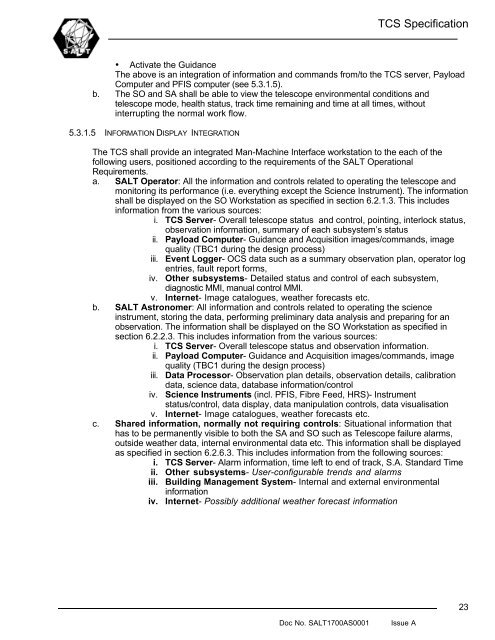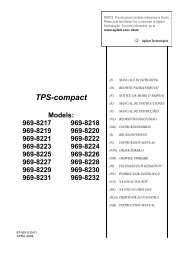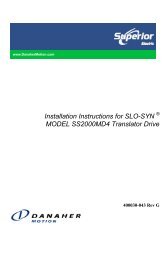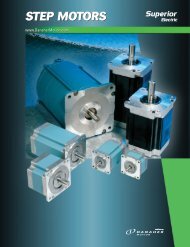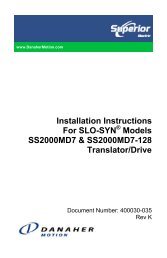1700AS0001 TCS Spec.pdf
1700AS0001 TCS Spec.pdf
1700AS0001 TCS Spec.pdf
Create successful ePaper yourself
Turn your PDF publications into a flip-book with our unique Google optimized e-Paper software.
Doc No. SALT<strong>1700AS0001</strong> Issue A<br />
<strong>TCS</strong> <strong>Spec</strong>ification<br />
• Activate the Guidance<br />
The above is an integration of information and commands from/to the <strong>TCS</strong> server, Payload<br />
Computer and PFIS computer (see 5.3.1.5).<br />
b. The SO and SA shall be able to view the telescope environmental conditions and<br />
telescope mode, health status, track time remaining and time at all times, without<br />
interrupting the normal work flow.<br />
5.3.1.5 INFORMATION DISPLAY INTEGRATION<br />
The <strong>TCS</strong> shall provide an integrated Man-Machine Interface workstation to the each of the<br />
following users, positioned according to the requirements of the SALT Operational<br />
Requirements.<br />
a. SALT Operator: All the information and controls related to operating the telescope and<br />
monitoring its performance (i.e. everything except the Science Instrument). The information<br />
shall be displayed on the SO Workstation as specified in section 6.2.1.3. This includes<br />
information from the various sources:<br />
i. <strong>TCS</strong> Server- Overall telescope status and control, pointing, interlock status,<br />
observation information, summary of each subsystem’s status<br />
ii. Payload Computer- Guidance and Acquisition images/commands, image<br />
quality (TBC1 during the design process)<br />
iii. Event Logger- OCS data such as a summary observation plan, operator log<br />
entries, fault report forms,<br />
iv. Other subsystems- Detailed status and control of each subsystem,<br />
diagnostic MMI, manual control MMI.<br />
v. Internet- Image catalogues, weather forecasts etc.<br />
b. SALT Astronomer: All information and controls related to operating the science<br />
instrument, storing the data, performing preliminary data analysis and preparing for an<br />
observation. The information shall be displayed on the SO Workstation as specified in<br />
section 6.2.2.3. This includes information from the various sources:<br />
i. <strong>TCS</strong> Server- Overall telescope status and observation information.<br />
ii. Payload Computer- Guidance and Acquisition images/commands, image<br />
quality (TBC1 during the design process)<br />
iii. Data Processor- Observation plan details, observation details, calibration<br />
data, science data, database information/control<br />
iv. Science Instruments (incl. PFIS, Fibre Feed, HRS)- Instrument<br />
status/control, data display, data manipulation controls, data visualisation<br />
v. Internet- Image catalogues, weather forecasts etc.<br />
c. Shared information, normally not requiring controls: Situational information that<br />
has to be permanently visible to both the SA and SO such as Telescope failure alarms,<br />
outside weather data, internal environmental data etc. This information shall be displayed<br />
as specified in section 6.2.6.3. This includes information from the following sources:<br />
i. <strong>TCS</strong> Server- Alarm information, time left to end of track, S.A. Standard Time<br />
ii. Other subsystems- User-configurable trends and alarms<br />
iii. Building Management System- Internal and external environmental<br />
information<br />
iv. Internet- Possibly additional weather forecast information<br />
23


